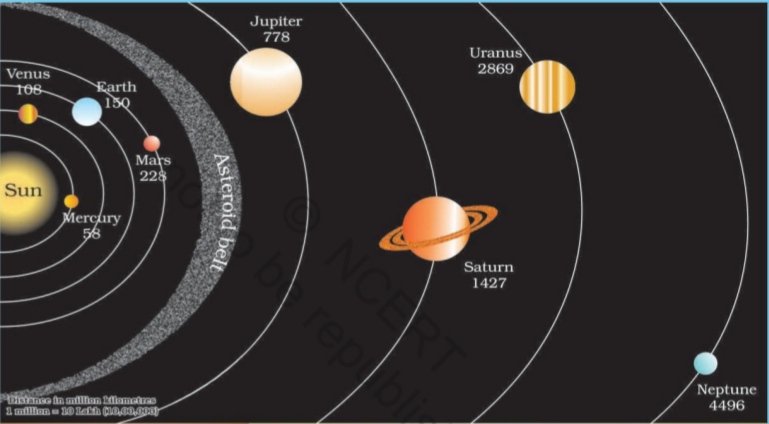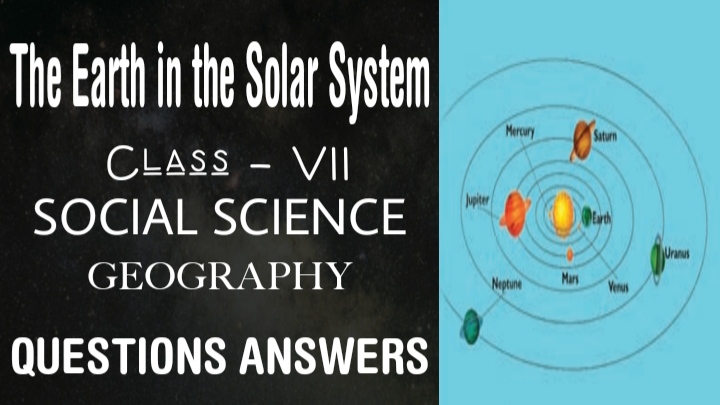The Earth in the Solar System class 7 Social Science (Geography) Questions Answers
The Earth in the Solar System class 7 Social Science (Geography) Questions Answers: The Earth in the Solar System is the class 7 Geography chapter 2 from class 7 Social Science NCERT text-book. Here you'll get The Earth in the Solar System class 7 Social Science (Geography) Questions Answers.
Class 7 Geography chapter 2 Notes (Social Science) The Earth in the Solar System
The sun is considered the “head” of the solar system. It is a star, although it is smaller and less bright than most other stars. It is a huge celestial body made up of extremely hot gases. It provides heat and light for the whole of the solar system. The sun is about 150 million kms away from the earth.
The solar family consists of the sun, planets, their satellites, asteroids and meteoroids.
Planets: Some celestial bodies do not have their own heat and light. They are lit by the light of the stars.
The word ‘planet’ is derived from the Greek word ‘Planetai’.
Satellites: A Satellite is a celestial body that moves around the planets in the same way as the planets move around the sun.
Asteroids: Asteroids are the numerous tiny celestial bodies which revolve around the sun and are mainly found between the orbits of Mars and Jupiter.
Meteoroids: Small pieces of rocks which move around the sun are called meteoroids.
Galaxy is a term that refers to billions of stars, clouds of dust and gases, and other celestial bodies considered as a single unit. The only bigger unit in the universe, galaxies make up the universe. The galaxy we live in is called the Milky Way.
 |
| Pic: Milky Way |
The earth is called the blue planet because it appears blue from when seen from the outer space since it has over 2/3rd of water. The Venus is called “Earth’s twin” because it is similar to Earth in its shape and size.
The moon is the only natural satellite of our planet earth while INSAT is an artificial satellite. The moon's diameter is just about a quarter of the earth’s diameter. It is comparatively closer (3,84,400 kilometers away) to earth than all other celestial bodies. It does not support life.
It revolves around the earth and rotates about its own axis in about the same time, due to which only one side of the moon is visible to us. The moon takes approximately 27 days to revolve once around the earth.
NCERT Solutions for Class 6 Social Science Geography Chapter 1 The Earth in the Solar System
1. Answer the following questions briefly.
(a) How does a planet differ from a star ?
Ans: A planet is different from a star, planets do not have their own heat and light. They are lit by the heat and light of the stars. But starts are very big and hot. They are made up of gases and they have their own heat and light. eg. The earth is an example of planet and the sun is an example of star.
(b) What is meant by the ‘Solar System’ ?
Ans: The Solar System refers to the “family” of the Sun. The Sun is a star around which eight planets, among other celestial objects, revolve in orbits. The Sun is the “head” of this system and this whole system of bodies is called the Solar System.
(c) Name all the planets according to their distance from the sun.
Ans: The list of planets according to their distance from the Sun are Mercury, Venus, Earth, Mars, Jupiter, Saturn, Uranus, Neptune
 |
| Pic: Solar System |
(d) Why is the Earth called a unique planet ?
Ans: The Earth is called s a unique planet because of the following reasons;
(i) The earth is the only planet known to support life.
(ii) It also has a temperature range that supports life.
(iii) It has oxygen and water present in proportions that allow life to thrive.
(iv) The proportion of water present is about two-thirds of the surface of the earth when compared to land.
(e) Why do we see only one side of the moon always ?
Ans: One revolution of the moon around the earth takes about 27 days. Incidentally, the moon’s rotation about its own axis also takes nearly the same time. One day of the moon is equal to 27 Earth days. So only one side of the moon can be seen from the earth.
(f) What is the Universe ?
Ans: The Universe is the largest unit in which we live. It is a collection of galaxies. There is only one Universe and everything that exists in this Universe itself.
NCERT Solutions of Class 6 Social Science Geography Chapter 1 The Earth in the Solar System
2. Tick the correct answer.
(a) The planet known as the “Earth’s Twin” is
(i) Jupiter (ii) Saturn (iii) Venus
Ans: Venus
(b) Which is the third nearest planet to the sun ?
(i) Venus (ii) Earth (iii) Mercury
Ans: Earth
(c) All the planets move around the sun in a
(i) Circular path (ii) Rectangular path (iii) Elongated path
Ans: Elongated path
(d) The Pole Star indicates the direction to the
(i) South (ii) North (iii) East
Ans: North
(e) Asteroids are found between the orbits of
(i) Saturn and Jupiter (ii) Mars and Jupiter (iii) The Earth and Mars
Ans: Mars and Jupiter
The Earth in the Solar System class 6 Geography Questions Answers
3. Fill in the blanks.
(a) A group of ________ forming various patterns is called a ________.
(b) A huge system of stars is called________.
(c) ________is the closest celestial body to our earth.
(d) ________is the third nearest planet to the sun.
(e) Planets do not have their own________ and ___________________.
Ans:
(a) A group of stars forming various patterns is called a constellation.
(b) A huge system of stars is called galaxy.
(c) The moon is the closest celestial body to our earth.
(d) The earth is the third nearest planet to the sun.
(e) Planets do not have their own heat and light.








No comments:
Post a Comment
Kindly donnot paste any SPAM link. Thank you very much for reading, Happy learning.